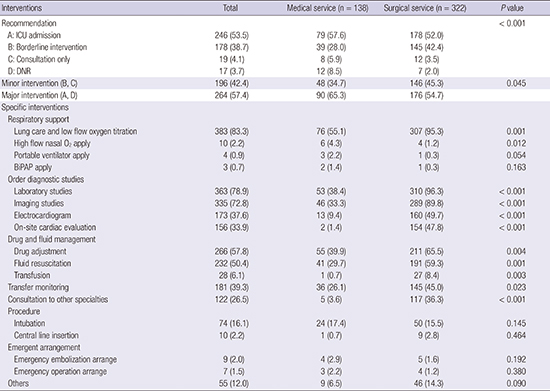1. Mercer M, Robinson H. Outreach and the evolution of critical care. Anaesthesia. 2010; 65:754.
2. Berwick DM, Calkins DR, McCannon CJ, Hackbarth AD. The 100,000 lives campaign: setting a goal and a deadline for improving health care quality. JAMA. 2006; 295:324–327.
3. DeVita MA, Braithwaite RS, Mahidhara R, Stuart S, Foraida M, Simmons RL; Medical Emergency Response Improvement Team (MERIT). Use of medical emergency team responses to reduce hospital cardiopulmonary arrests. Qual Saf Health Care. 2004; 13:251–254.
4. Buist MD, Moore GE, Bernard SA, Waxman BP, Anderson JN, Nguyen TV. Effects of a medical emergency team on reduction of incidence of and mortality from unexpected cardiac arrests in hospital: preliminary study. BMJ. 2002; 324:387–390.
5. Bellomo R, Goldsmith D, Uchino S, Buckmaster J, Hart GK, Opdam H, Silvester W, Doolan L, Gutteridge G. A prospective before-and-after trial of a medical emergency team. Med J Aust. 2003; 179:283–287.
6. Chan PS, Khalid A, Longmore LS, Berg RA, Kosiborod M, Spertus JA. Hospital-wide code rates and mortality before and after implementation of a rapid response team. JAMA. 2008; 300:2506–2513.
7. Sharek PJ, Parast LM, Leong K, Coombs J, Earnest K, Sullivan J, Frankel LR, Roth SJ. Effect of a rapid response team on hospital-wide mortality and code rates outside the ICU in a Children’s Hospital. JAMA. 2007; 298:2267–2274.
8. Wood KA, Ranji SR, Ide B, Dracup K. Rapid response systems in adult academic medical centers. Jt Comm J Qual Patient Saf. 2009; 35:475–482.
9. Devita MA, Bellomo R, Hillman K, Kellum J, Rotondi A, Teres D, Auerbach A, Chen WJ, Duncan K, Kenward G, et al. Findings of the first consensus conference on medical emergency teams. Crit Care Med. 2006; 34:2463–2478.
10. Priestley G, Watson W, Rashidian A, Mozley C, Russell D, Wilson J, Cope J, Hart D, Kay D, Cowley K, et al. Introducing critical care outreach: a ward-randomised trial of phased introduction in a general hospital. Intensive Care Med. 2004; 30:1398–1404.
11. Henning RJ, McClish D, Daly B, Nearman H, Franklin C, Jackson D. Clinical characteristics and resource utilization of ICU patients: implications for organization of intensive care. Crit Care Med. 1987; 15:264–269.
12. Le Gall JR, Brun-Buisson C, Trunet P, Latournerie J, Chantereau S, Rapin M. Influence of age, previous health status, and severity of acute illness on outcome from intensive care. Crit Care Med. 1982; 10:575–577.
13. Lee YJ, Park JJ, Yoon YE, Kim JW, Park JS, Kim T, Lee JH, Suh JW, Jo YH, Park S, et al. Successful implementation of a rapid response system in the department of internal medicine. Korean J Crit Care Med. 2014; 29:77–82.
14. Wax RS. Key elements of an RRS. In : Sebat F, editor. Society of Critical Care Medicine. Designing, Implementing, and Enhancing a Rapid Response System. Mount Prospect, IL: Society of Critical Care Medicine;2009. p. 31–40.
15. Huh JW, Lim CM, Koh Y, Lee J, Jung YK, Seo HS, Hong SB. Activation of a medical emergency team using an electronic medical recording-based screening system. Crit Care Med. 2014; 42:801–808.
16. Sarani B, Palilonis E, Sonnad S, Bergey M, Sims C, Pascual JL, Schweickert W. Clinical emergencies and outcomes in patients admitted to a surgical versus medical service. Resuscitation. 2011; 82:415–418.
17. Calzavacca P, Licari E, Tee A, Egi M, Haase M, Haase-Fielitz A, Bellomo R. A prospective study of factors influencing the outcome of patients after a Medical Emergency Team review. Intensive Care Med. 2008; 34:2112–2116.
18. Williams M. Infection control and prevention in perioperative practice. J Perioper Pract. 2008; 18:274–278.
19. Spell NO 3rd. Stopping and restarting medications in the perioperative period. Med Clin North Am. 2001; 85:1117–1128.
20. Smith MS, Muir H, Hall R. Perioperative management of drug therapy, clinical considerations. Drugs. 1996; 51:238–259.
21. McAlister FA, Bertsch K, Man J, Bradley J, Jacka M. Incidence of and risk factors for pulmonary complications after nonthoracic surgery. Am J Respir Crit Care Med. 2005; 171:514–517.
22. Warner ME. Risks and outcomes of perioperative pulmonary aspiration. J Perianesth Nurs. 1997; 12:352–357.
23. Gardner-Thorpe J, Love N, Wrightson J, Walsh S, Keeling N. The value of Modified Early Warning Score (MEWS) in surgical in-patients: a prospective observational study. Ann R Coll Surg Engl. 2006; 88:571–575.
24. Goldhill DR, McNarry AF, Mandersloot G, McGinley A. A physiologically-based early warning score for ward patients: the association between score and outcome. Anaesthesia. 2005; 60:547–553.









 PDF
PDF ePub
ePub Citation
Citation Print
Print




 XML Download
XML Download